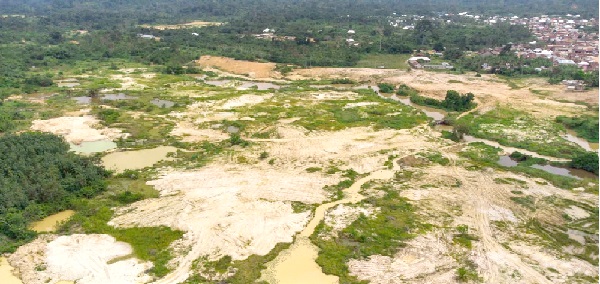Ghana will need billions of dollars to treat, reclaim and restore vast degraded lands and waterbodies caused by activities of illegal miners over the years.
Professor Nana Browne Klutse, the Acting Chief Executive Officer, Environmental Protection Authority (EPA), described the situation as an emergency and appealed to development partners to support the country.
Speaking to the Ghana News Agency on Tuesday, she gave a hint that a world bank funded project had helped reclaim some lands, but it was at a pilot stage and the EPA would need funding to upscale.
“We have been approached by companies to help the country reclaim and restore but the condition is for Ghana to pay for the technology after the pilot stage,” Prof. Klutse said.
The ideal situation was to ensure all mining companies, after securing permits, to pay bonds to be used to reclaim the lands, Prof Brown Klutse said.
“In our current dispensation mining has occurred on vast lands by unidentified faces who have absconded. At the moment we have vast lands that have been degraded. We need to reclaim them, but we do not have the money to do that,” she said.
In line with the new Act giving the Agency an authority status, Environmental Protection Act 2025, (Act 1124) Prof. Klutse said the Authority had begun taking steps to increase its presence in the local areas to ensure effective monitoring and enforcement of laws prohibiting all forms of activities that pollute the environment.
“We realised that currently the Authority’s eyes are not everywhere but soon we will establish offices at the district level to educate the public, guide people on their undertaking and punish where necessary to ensure compliance,” she said.
Prof. Klutse assured that the public would see the water bodies being restored soon.
Illegal gold mining has been wreaking havoc in southern Ghana for years, particularly in resource-rich regions, such as the Upper Offin sub-basin.
According to International Water Management Institute’s study, these areas once celebrated for their dense forests and flourishing cocoa plantations, now face a grim reality of land degradation, plummeting agricultural yields, and polluted water bodies.
In 2024, the Centre for Remote Sensing and Geographic Information Services, through the SERVIR West Africa programme, revealed that more than 670 square kilometres of land – an area comparable to the size of Singapore -had been destroyed by illegal mining.
High water turbidity, which is a measure of the amount of suspended solids/particles in water from galamsey, can harm water quality, ecosystems, and human health.
In March, last year, the Ghana Water Limited complained about challenges with high turbidity levels in treating water to make it potable for the people of Sekondi-Takoradi.
The Daboase Water Treatment Plant, it said, was recording alarmingly high levels of turbidity.
The company, which initially had to deal with only 100 Nephelometric Turbidity Units (NTU) at the time of construction of the plant, was now grappling with 7000 NTU.
This has resulted in the frequent breakdown of machinery and cost of chemicals for treatment.
Turbidity levels from galamsey have been recorded as high as 14,000 nephelometric turbidity units (NTU), which is far above the 2,000 NTU limit.
Toxic chemicals from galamsey also contaminate water bodies leading people to seek alternative water sources, which are too expensive or unsafe.
High turbidity also causes algae blooms that can harm food chains and food webs.
Research also links water pollution from galamsey to chronic diseases such as kidney failure, birth defects, and cancer.
The Pra, Ankobra, Birim, Offin, Densu and Oti rivers have all been polluted by illegal mining.
GNA





